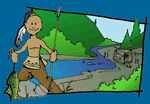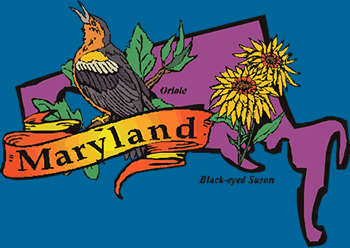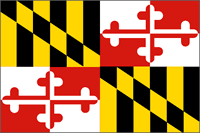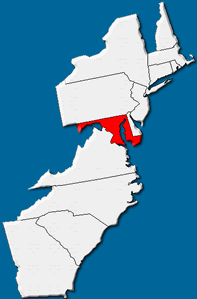


Geography and Landforms:
The Chesapeake Bay divides Maryland into two sections -the Eastern Shore and the Western Shore. The state is made up of 5 distinct land regions.
|
 History:
In 1608, Captain John Smith of the Virginia Colony sailed north into the Chesapeake Bay and wrote the first description of the land that became Maryland. The first permanent settlement was made in 1631 when William Claiborne of the Virginia colony established a trading post on Kent Island.
|
 Economy:
The Atlantic coastal waters and Chesapeake Bay provide Maryland with a busy fishing industry. The state's annual catch of crabs is the largest in the United States. Aquaculture, or fish farming, is important to Maryland's economy. Aquafarms within the state produce striped bass, catfish, tilapia, and shellfish as well as ornamental fish and aquatic plants.
|
 First Inhabitants:
Several tribes of Algonkian Indians once inhabited the region now known as the state of Maryland. They included the Choptank, Nanticoke, Patuxent, Portobago, and Wicomico tribes.
|
Books Related To Maryland12 Things to Do before You Crash and Burn - James Proimos A Face First - Priscilla Cummings B is for Blue Crab: A Maryland Alphabet - Shirley Menendez The Civil War Totally Made Up Diary of Amanda MacLeish - Claudia Mills Clara and the Bookwagon - Nancy Smiler Levinson Dangerously Alice - Phyllis Reynolds Naylor Jake - Audrey Couloumbis Promises to the Dead - Mary Downing Hahn Red Kayak - Priscilla Cummings Shakespeare's Secret - Elise Broach The Trouble with Mark Hopper - Elissa Brent Weissman |
Famous Citizens:
|
| Capital: | Annapolis |
| Entered Union: | April 28, 1788 |
| Population: | 5,976,407 |
| Area | 12,407 |
| Bird | Baltimore Oriole |
| Flower | Black-eyed Susan |
| Nickname: | Old Line State |
| Governor | Larry Hogan |
Places to Visit in Maryland: (Click the links to learn more.)
|



